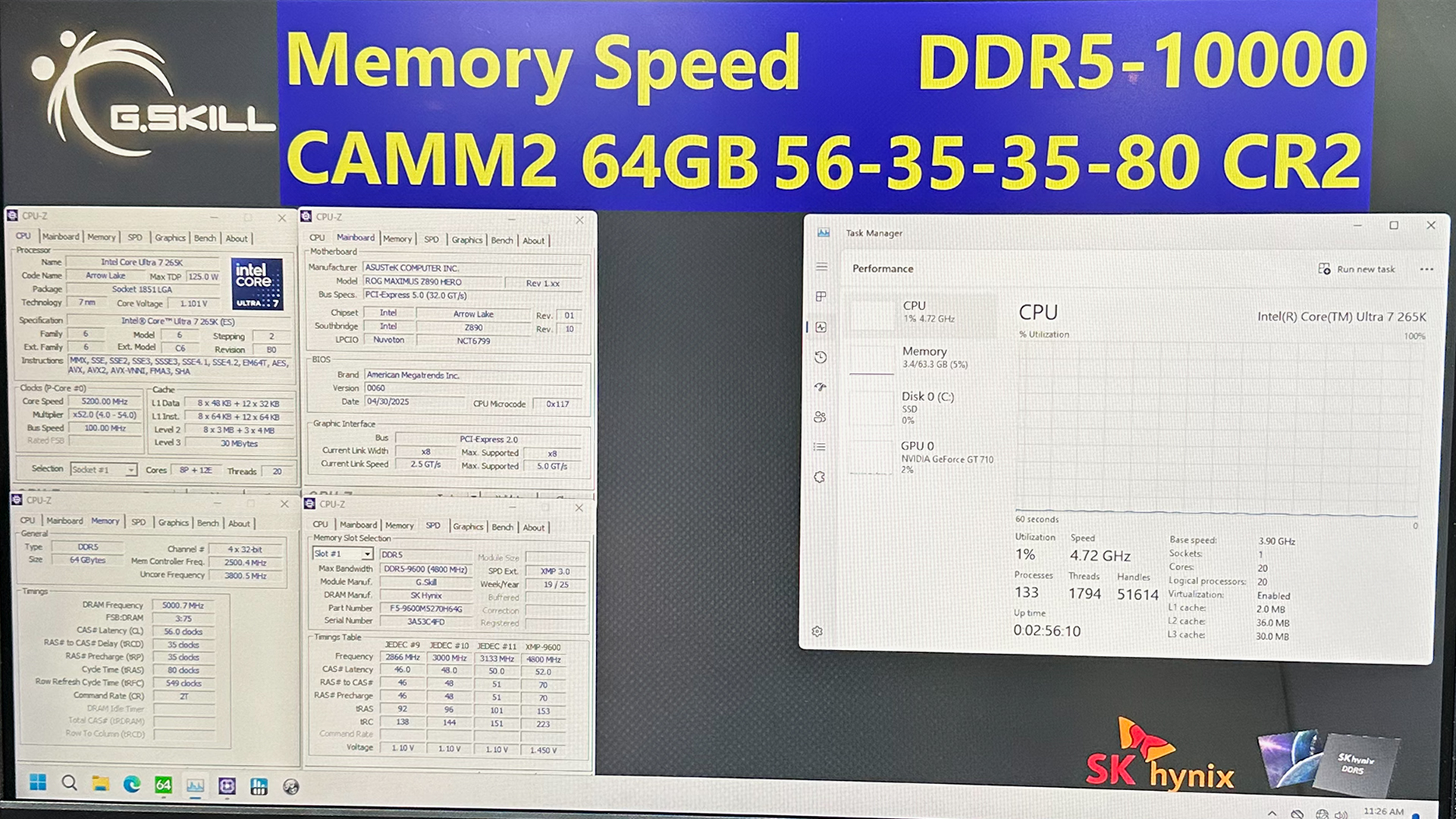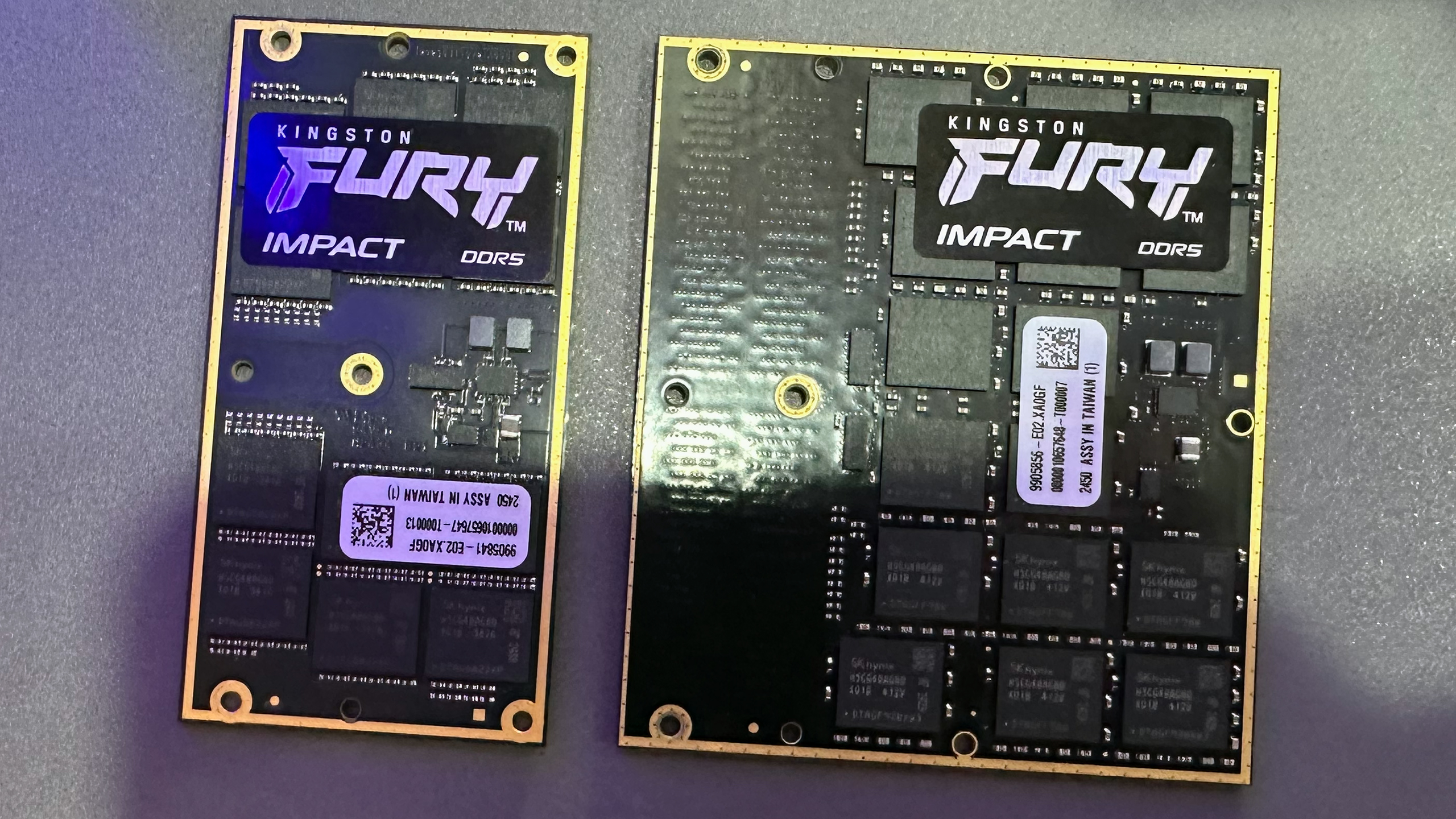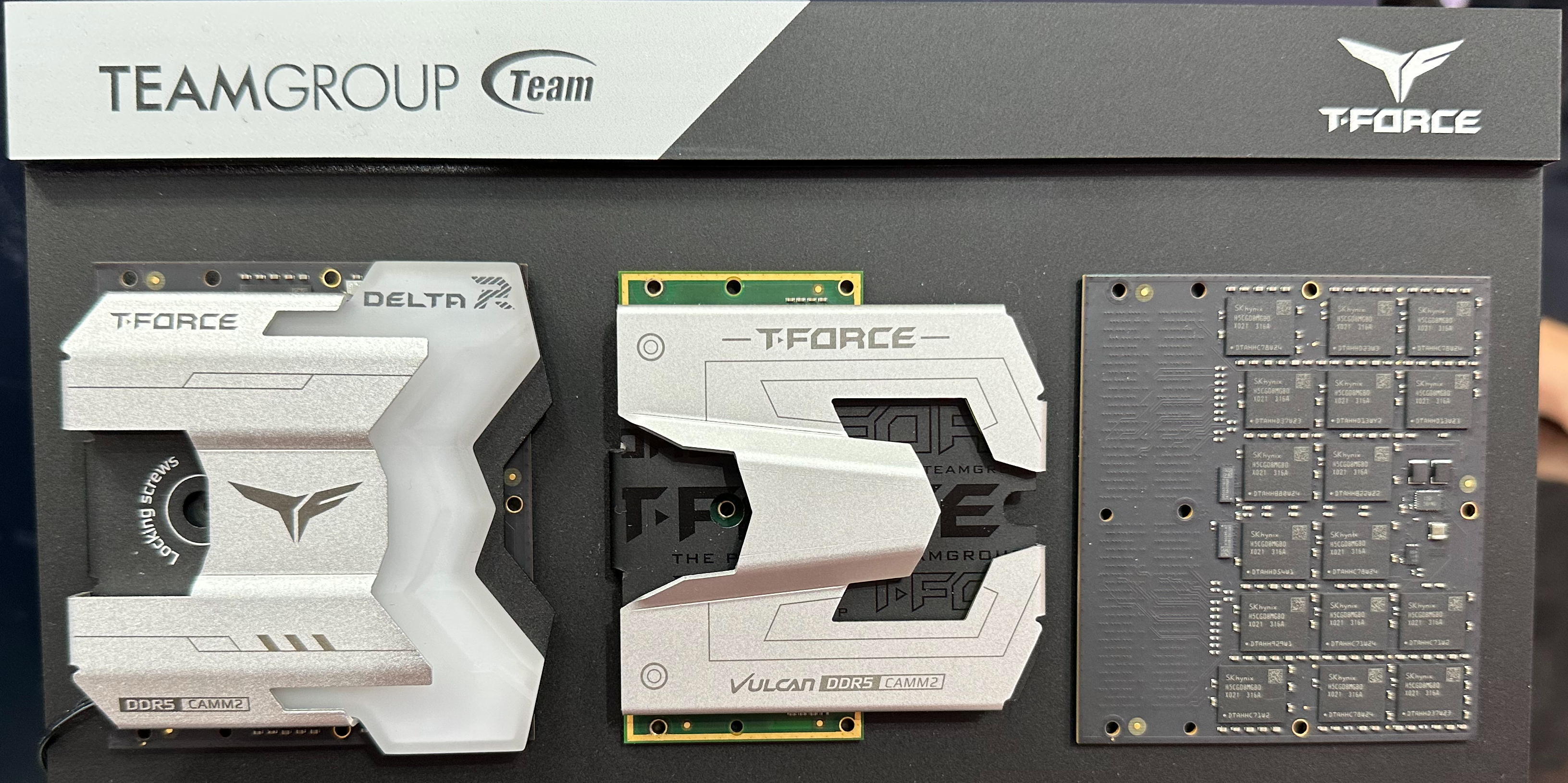CAMM2 and modules smile to the camera, but do not expect them on the market soon

Multiple manufacturers of enthusiast-grade DRAM modules demonstrated compression-attached memory CAMM2 modules at Computex 2025, indicating their interest in this form factor. However, none of the manufacturers are confident that these DDR5 modules will hit the market as they are unsure when motherboard makers will release suitable platforms.
We saw CAMM2 memory modules from G.Skill, Kingston, and TeamGroup at the trade show in Taipei, Taiwan. Modules from G.Skill and TeamGroup come with elevated data transfer rates (DDR5-10,000 and DDR5-8000, respectively). Additionally, TeamGroup equipped its CAMM2 module with heat spreaders and addressable RGB LEDs, indicating that they are aimed at enthusiasts. G.Skill even demonstrated an overclocked version of its DDR5-10,000 CAMM2 module with shrunk timings.
Company | Transfer Rate | Timings | Capacity | Voltage | DRAM | Note |
G.Skill | DDR5-10000 | CL56 70-70 | 64GB | 1.45V | SK hynix | announced |
G.Skill | DDR5-10000 | CL56 35-35-80 | 64GB | 1.45V | SK hynix | demonstrated |
Kingston | ? | ? | 32GB, 48GB, 64GB, 96GB, 128GB | ? | SK hynix | - |
TeamGroup | DDR5-8000 | CL42 50-50-84 | 32GB | 1.4V | SK hynix | - |
Kingston demonstrated two versions of its enthusiast-grade Fury-branded CAMM2 modules (just like G.Skill) but did not publish the speed bins it plans to support. Additionally, while Kingston partnered with Gigabyte's Aorus for the Z890 Aorus Tachyon Ice CAMM2 motherboard, its advertising materials state that its Fury Impact DDR5 CAMM2 modules are "ideal for notebook and mobile workstation users."

CAMM2 modules from Kingston.

However, demonstrations of compression attached memory modules at Computex were not limited to CAMM2. SK hynix demonstrated its LPDDR5X-based SOCAMM2 modules as well, though this form-factor is for now specific to Nvidia's Grace Blackwell platforms. Several makers of modules — including Micron and SK hynix's affiliate Klevv — also showcased LPCAMM2 modules mainly aimed at compact and mobile systems, which highlights that the form-factor is gradually becoming more widespread, and these makers envision aftermarket demand for them.
CAMM and LPCAMM2 memory modules have an indisputable advantage over regular DIMMs and SODIMMs in terms of capacity density and interface width (128-bit) over regular DIMMs. CAMM2 also promises to improve signal integrity by reducing electrical path lengths, enabling higher data transfer rates and better power efficiency. However, memory modules can increase performance potential on modern platforms by adding clock driver chips to their products even without adopting an all-new form-factor.
CAMM2 also comes with trade-offs compared to conventional DIMMs. Adoption is still limited, and upgradability, while possible, is not as user-friendly as the straightforward plug-and-play nature of DIMMs. For now, the ecosystem for CAMM2 modules is also nascent, as while leading motherboard makers are all teasing CAMM2-supporting platforms, they have not yet committed to releasing them. To that end, only select makers of memory modules have even developed prototype CAMM2 modules.
One of the peculiarities of the market of enthusiast-grade PC hardware is that it tends to adopt all the latest and greatest technologies and then figure out whether they make sense regarding performance and cost. SSDs, mechanical keyboards, and ultra-high-resolution displays used to be a prerogative of enthusiast-grade builds for gaming. Today, they are used in mass market PCs. However, some technologies — 3D monitors, hybrid storage drives, and Intel's BTX form-factor — flounder in the market, whereas other — HBM, multi-GPU setups, PCIe add-in-card SSDs — become successful niche products. Only time will tell what happens to compression attached modules on the desktop market.
Get Tom's Hardware's best news and in-depth reviews, straight to your inbox.
Follow Tom's Hardware on Google News to get our up-to-date news, analysis, and reviews in your feeds. Make sure to click the Follow button.

Anton Shilov is a contributing writer at Tom’s Hardware. Over the past couple of decades, he has covered everything from CPUs and GPUs to supercomputers and from modern process technologies and latest fab tools to high-tech industry trends.
-
Jame5 Give me dual channel CAMM2 128GB modules at DDR5-10000 and I'll be happy.Reply
Realistically though, it seems that CAMM2 gets it's 128-bit bus by just jamming both 64-bit busses from a dual channel memory controller into a single interface. Which means every solution we've seen is a single module solution. That means max capacity will continue to flounder at 128GB of RAM for any platform that adopts CAMM2.
I really hope I'm wrong, but so far I have not seen a dual-module motherboard prototype. -
usertests So that's what gamer CAMM would look like.Reply
DDR5 DIMMs and SODIMMs are too established for CAMM to matter. CAMM will play a role in the DDR6 generation because there won't be DDR6 SODIMMs.Jame5 said:Which means every solution we've seen is a single module solution. That means max capacity will continue to flounder at 128GB of RAM for any platform that adopts CAMM2.
I'm not sure about desktop, but you can now get 128-256 GB from 64 GB DIMMs, and that will carry over to DDR6. Is the CAMM form factor helping with board space vs. DIMMs sticking out vertically? -
thestryker Reply
There's a type D which is the same capacity as type B (the larger one from the article here) but is single channel (and slightly smaller at 57mm rather than 68mm) so 256GB is possible. The issue with CAMM2 in single channel mode is that the modules are stacked. This is unlikely to be a problem at JEDEC speeds, but very likely would be for OC speeds. I'm pretty sure this is why none of the examples have been single channel. I assume the only single channel CAMM2 that will exist would be workstation laptops/enterprise systems.Jame5 said:Realistically though, it seems that CAMM2 gets it's 128-bit bus by just jamming both 64-bit busses from a dual channel memory controller into a single interface. Which means every solution we've seen is a single module solution. That means max capacity will continue to flounder at 128GB of RAM for any platform that adopts CAMM2.
I really hope I'm wrong, but so far I have not seen a dual-module motherboard prototype. -
thestryker Reply
Once you go past type A CAMM2 takes up a lot more board surface area than DIMMs. In single channel mode CAMM2 could have higher 1DPC capacity, but that's the only obvious advantage. At this point I wouldn't actually be surprised if 2DPC was dead with DDR6 though.usertests said:Is the CAMM form factor helping with board space vs. DIMMs sticking out vertically? -
-Fran- Reply
You're not wrong, but I actually like the vertical space being "freed up" by the CAMM2 modules, so that CPU coolers can improve a tad more with more exotic heat pipe configurations. Who knows, maybe with the CAMM2 motherboards we can now have GPU-style CPU coolers? I do like the idea, at least from a concept perspective.thestryker said:Once you go past type A CAMM2 takes up a lot more board surface area than DIMMs. In single channel mode CAMM2 could have higher 1DPC capacity, but that's the only obvious advantage. At this point I wouldn't actually be surprised if 2DPC was dead with DDR6 though.
As for the other points. The only benefit they bring is better signaling without the need of the external clock generator like CUDIMMs, which can also help a potential "clocked" CAMM2 module (they'd still be CUDIMMs, lel).
Perhaps when new sockets roll out, that's when the "clean slate" could happen and just treat DDR5 as a test bed for the idea.
Personally, I do like the form factor. Specially because it may enable both laptop and PC to share the same memory types down the line? Perhaps?
Regards. -
thestryker Reply
CAMM2 has the same clock driver support DIMMs do. JEDEC DDR5 spec sheet isn't free sadly so I don't know if CKD is mandatory for certain speeds across the board, but it is required for UDIMMs/SODIMMs on everything 6400 and above.-Fran- said:As for the other points. The only benefit they bring is better signaling without the need of the external clock generator like CUDIMMs, which can also help a potential "clocked" CAMM2 module (they'd still be CUDIMMs, lel).
CAMM2 has two separate interfaces one for DDR and one for LPDDR. Otherwise it's just a matter of there being enough space for the different PCB types. Even though that isn't perfect it's definitely an improvement over what we've got now. Now if we could just convince laptop makers to unlock memory tweaking!-Fran- said:Personally, I do like the form factor. Specially because it may enable both laptop and PC to share the same memory types down the line? Perhaps?


